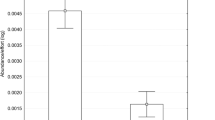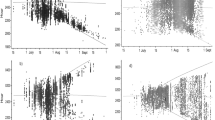Abstract
Animals are exposed to many conflicting ecological pressures, and the effect of one may often obscure that of another. A likely example of this is the so-called “lunar phobia” or reduced activity of bats during full moon. The main reason for lunar phobia was thought to be that bats adjust their activity to avoid predators. However, bats can be prey, but many are carnivorous and therefore predators themselves. Thus, they are likely to be influenced by prey availability as well as predation risk. We investigated the activity patterns of the perch-hunting Lophostoma silvicolum and one of its main types of prey, katydids, to assess the influence of the former during different phases of the lunar cycle on a gleaning insectivorous bat. To avoid sampling bias, we used sound recordings and two different capture methods for the katydids, as well as video monitoring and radio-telemetry for the bats. Both, bats and katydids were significantly more active during the dark periods associated with new moon compared to bright periods around the full moon. We conclude that foraging activity of L. silvicolum is probably influenced by prey availability to a large extent and argue that generally the causes of lunar phobia are species-specific.




Similar content being viewed by others
References
Aldridge H, Brigham RM (1988) Load carrying and maneuverability in an insectivorous bat - a test of the 5-percent rule of radio-telemetry. J Mammal 69:379–382
Altringham JD (1996) Bats—biology and behaviour. Oxford University Press, Oxford
Belwood JJ (1988) The influence of bat predation on calling behaviour in Neotropical forest katydids (Insecta: Orthoptera: Tettigoniidae). Doctoral Thesis, University of Florida
Belwood JJ, Morris GK (1987) Bat predation and its influence on calling behavior in Neotropical katydids. Science 238:64–67
Bockholdt C (1998) Hangplatzwahl, Aktivitätsrhythmik und Aktionsraum der neotropischen Fledermaus Tonatia silvicola (D’Orbigny, 1836). Diploma Thesis, University of Freiburg
Brigham RM, Barclay RMR (1992) Lunar influence on foraging and nesting activity of common whippoorwills (Phalaenoptilus nuttallii). Auk 109:315–320
Brown ES, Taylor LR (1971) Lunar cycles in distribution and abundance of airborne insects in equatorial highlands of East Africa. J Anim Ecol 40:767–779
Daly M, Behrends PR, Wilson MI, Jacobs LF (1992) Behavioral modulation of predation risk - Moonlight avoidance and crepuscular compensation in a nocturnal desert rodent, Dipodomys merriami. Anim Behav 44:1–9
Dechmann DKN, Kalko EKV, Kerth G (2004) Ecology of an exceptional roost: energetic benefits could explain why the bat Lophostoma silvicolum roosts in active termite nests. Evol Ecol Res 6:1037–1050
Erkert HG (1974) Der Einfluss der Mondlichtes auf die Aktivitätsperiodik nachtaktiver Säugetiere. Oecologia 14:269–287
Erkert HG (1978) Sunset-related timing of flight activity in Neotropical bats. Oecologia 37:59–67
Fenton MB, Rautenbach IL, Smith SE, Swanepoel CM, Grosell J, Vanjaarsveld J (1994) Raptors and bats—threats and opportunities. Anim Behav 48:9–18
Fleming TH, Heithaus ER (1986) Seasonal foraging behavior of the frugivorous bat Carollia perspicillata. J Mammal 67:660–671
Flores-Crespo R, Linhart SB, Burns RJ, Mitchell GC (1972) Foraging behavior of the common vampire bat related to moonlight. J Mammal 53:366–368
Gannon MR, Willig MR (1997) The effect of lunar illumination on movement and activity of the red fig-eating bat (Stenoderma rufum). Biotropica 29:525–529
Haemsch F (1998) Aktionsraum, Jagdgebiete, Aktivitätsmuster und Jagdstrategie der froschfressenden Fledermaus, Trachops cirrhosus. Diploma Thesis, University of Tübingen
Haeussler U, Erkert H (1978) Different direct effects of light-intensity on entrained activity rhythm in Neotropical bats (Chiroptera, Phyllostomidae). Behav Process 3:223–239
Hecker KR, Brigham RM (1999) Does moonlight change vertical stratification of activity by forest-dwelling insectivorous bats? J Mammal 80:1196–1201
Heithaus ER, Fleming TH (1978) Foraging movements of a frugivorous bat, Carollia perspicillata (Phyllostomatidae). Ecol Mon 48:127–143
Horning M, Trillmich F (1999) Lunar cycles in diel prey migrations exert a stronger effect on the diving of juveniles than adult Galapagos fur seals. Proc R Soc Lond B 266:1127–1132
Kalko EKV, Handley CO, Handley D (1996) Organization, diversity, and long-term dynamics of a Neotropical bat community. In: Cody ML, Smallwood JA (eds) Long-term studies of vertebrate communities. Academic, Burlington, pp 503–553
Kalko EKV, Friemel D, Handley CO, Schnitzler HU (1999) Roosting and foraging behavior of two Neotropical gleaning bats, Tonatia silvicola and Trachops cirrhosus (Phyllostomidae). Biotropica 31:344–353
Karlsson BL, Eklof J, Rydell J (2002) No lunar phobia in swarming insectivorous bats (family Vespertilionidae). J Zool 256:473–477
Korine C, Kalko EKV, Herre EA (2000) Fruit characteristics and factors affecting fruit removal in a Panamanian community of strangler figs. Oecologia 123:560–568
Lang AB, Teppner I, Hartbauer M, Roemer H (2005) Predation and noise in communication networks of Neotropical kadydids. In: McGregor P (ed) Animal communication networks. Cambridge University Press, Cambridge, pp 152–169
Lee TE, Hoofer SR, Van Den Bussche RA (2002) Molecular phylogenetics and taxonomic revision of the genus Tonatia (Chiroptera: Phyllostomidae). J Mammal 83:49–57
Leigh EG (1999) Tropical forest ecology: a view from Barro Colorado Island. Oxford University Press, Oxford
Lockard RB (1978) Seasonal change in the activity pattern of Dipodomys spectabilis. J Mammal 59:563–568
Meyer CFJ, Schwarz CJ, Fahr J (2004) Activity patterns and habitat preferences of insectivorous bats in a West African forest-savanna mosaic. J Trop Ecol 20:1–14
Mills AM (1986) The influence of moonlight on the behavior of goatsuckers (Caprimulgidae). Auk 103:370–378
Morrison DW (1978) Lunar phobia in a Neotropical fruit bat, Artibeus jamaicensis (Chiroptera Phyllostomidae). Anim Behav 26:852–855
Morrison DW, Handley CO (1991) Roosting behavior. In: Handley CO, Wilson DE, Gardner AI (eds) Demography and natural history of the common fruit bat, Artibeus jamaicensis, on Barro Colorado Island, Panama. Smithson Inst Press, Washington, pp 131–135
Munz FW, McFarland WN (1977) Evolutionary adaptations of fishes to the photic environment. In: Crescitelli F (ed) Handbook of sensory physiology. Springer, Berlin Heidelberg New York, pp 193–274
Negraeff OE, Brigham RM (1995) The influence of moonlight on the activity of little brown bats (Myotis lucifugus). Int J Mammal Biol 60:330–336
Nickle DA (1992) Katydids of Panama (Orthoptera: Tettigoniidae). In: Quintero D, Aiello A (eds) Insects of Panama and Mesoamerica, selected studies. Oxford University Press, Oxford, pp 142–184
Nickle DA, Heymann EW (1996) Predation on orthoptera and other orders of insects by tamarin monkeys, Saguinus mystax mystax and Saguinus fuscicollis nigrifrons (Primates: Callitrichidae), in north-eastern Peru. J Zool 239:799–819
Pagden RB (1932) Activity of Malayan moths. Malayan Agr J 20:120
Reith CC (1982) Insectivorous bats fly in shadows to avoid moonlight. J Mammal 63:685–688
Riede K (1997) Bioacoustic monitoring of insect communities in a Bornean rain forest canopy. In: Stork NE, Adis JA (eds) Canopy arthropods. Chapman & Hall, Norwell, pp 442–452
Rodriquez-Duran A, Vazquez R (2001) The bat Artibeus jamaicensis in Puerto Rico (West Indies): seasonality of diet, activity, and effect of a hurricane. Acta Chiropterol 3:53–61
Russo D, Jones G (2003) Use of foraging habitats by bats in a Mediterranean area determined by acoustic surveys: conservation implications. Ecography 26:197–209
Schnitzler HU, Kalko EKV (2001) Echolocation by insect-eating bats. Bioscience 51:557–569
Servatius A (1997) Das Jagd- und Echoortungsverhalten von d’Orbigny’s Rundohrenfledermaus Tonatia silvicola im Flugraum. Diploma Thesis, University of Tübingen
Speakman JR (1991) The impact of predation by birds on bat populations in the British-Isles. Mammal Rev 21:123–142
Thies W, Kalko EKV (2004) Phenology of neotropical pepper plants (Piperaceae) and their association with their main dispersers, two short-tailed fruit bats, Carollia perspicillata and C castanea (Phyllostomidae). Oikos 104:362–376
Tuttle MD, Ryan MJ (1982) The role of synchronized calling, ambient light, and ambient noise, in anti-bat-predator behavior of a treefrog. Behav Ecol Sociobiol 11:125–131
Waiping V, Fenton MB (1988) Nonselective mating in little brown bats (Myotis lucifugus). J Mammal 69:641–645
Weinbeer M, Kalko, EKV (2004) Morphological characteristics predict alternate foraging strategy and microhabitat selection in the gleaning bat, Lambronycteris brachyotis (Phyllostomidae). J Mammal 85:1116–1123
Williams CB (1936) The Influence of moonlight on the activity of certain nocturnal insects, particularly of the family Noctuidae, as indicated by a light trap. Phil Trans R Soc Lond B 226:357–389
Williams CB (1940) The analysis of four years captures of insects in a light trap, part 2: the effect of weather conditions on insect activity; and the estimation and forecasting of changes in the insect population. Trans R Entomol Soc Lond 90:227–306
Williams CB, Singh BP (1951) Effect of moonlight on insect activity. Nature 167:853–853
Williams CB, Singh BP, el Ziady S (1956) An investigation into the possible effects of moonlight on the activity of insects in the field. Proc R Entomol Soc Lond 31:135–144
Windsor DM (1990) Climate and moisture variability in a tropical forest: Long-term records from Barro Colorado Island, Panama. Smithson Contrib Earth Sci 29:1–145
Acknowledgments
This project was supported by the Austrian Academy for Sciences (DOC-2002) and the Karl-Franzens-University of Graz to ABL, the Roche Research Foundation, the ZUNIV-Fonds zur Förderung des Akademischen Nachwuchses (FAN) to DKND, the Austrian Science Fund (FWF-P14257) to HR. and the German Science Foundation (DFG) to EKVK. The following people helped with the fieldwork: Maria Demir, Silke Heucke, Jamie Mandel, Anita Schulz, Moritz Weinbeer, and especially Christa Weise, who also helped with proof reading and important discussions. Kamran Safi helped with the data analysis. Frieder Neuhäuser-Wespy supported development of equipment. Robert Barclay, Mark Brigham, Johan Eklof, Alan McElligott, Sabine Spehn and two anonymous reviewers gave valuable input on drafts of this paper. We are grateful to the Smithsonian Tropical Research Institute (STRI) and the National Authority for the Environment (ANAM) for research permits and logistical support, which ensured that all work was conducted in conformity with current Panamanian laws.
Author information
Authors and Affiliations
Corresponding author
Additional information
Communicated by Roland Brandl
Rights and permissions
About this article
Cite this article
Lang, A.B., Kalko, E.K.V., Römer, H. et al. Activity levels of bats and katydids in relation to the lunar cycle. Oecologia 146, 659–666 (2006). https://doi.org/10.1007/s00442-005-0131-3
Received:
Accepted:
Published:
Issue Date:
DOI: https://doi.org/10.1007/s00442-005-0131-3




